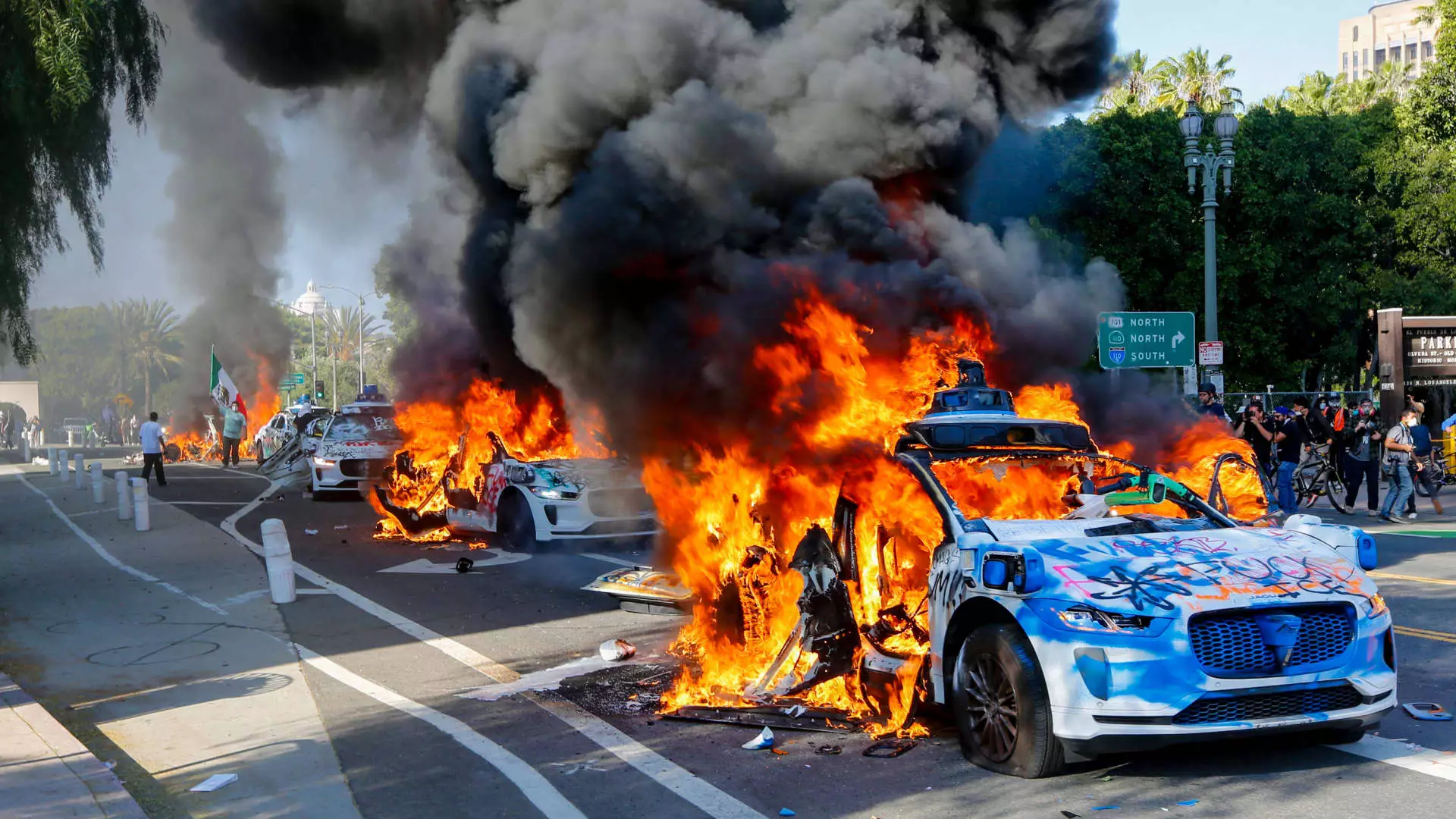In a world increasingly defined by technological advancement, the intersection of innovation and socio-political unrest has become an intriguing arena. Recent events in downtown Los Angeles serve as a case study of this phenomenon — a stark portrayal of how political controversies can erupt into physical manifestations of outrage, with unintended victims caught in the midst. The scene where several Waymo autonomous vehicles were set ablaze underlines not only the volatility of protest but also raises questions about the public’s relationship with technology in politically charged environments.
Situations like these demand a deeper understanding of the implications surrounding the technologies we are integrating into our daily lives. On one hand, autonomous vehicles promise enhanced safety, reduced traffic congestion, and environmental benefits; on the other, people find themselves grappling with broader concerns related to justice, fairness, and equity. When traditional forms of social protest face the robust machinery of tech giants, they may lash out against symbols of that technology, leading to violent acts like the recent incendiary strikes against Waymo vehicles. The articulated rage is significant — it expresses dissatisfaction that goes beyond mere vehicles, calling into question the very fabric of a society grappling with systemic issues.
Violence vs. Pacifism: An Ethical Dilemma
However, should acts of vandalism be romanticized as a form of revolutionary expression? This remains a contentious debate. Many would argue that violence undermines the legitimacy of the cause, diluting the message and reducing the potency of the claims being made against entities like Immigration and Customs Enforcement. When protesters resort to destroying property — especially autonomous vehicles owned by companies that may represent a different set of economic values — it muddies the waters of moral clarity. Citizens should continuously engage with the question: how does one confront systemic injustices without resorting to destructive means that further societal division?
The ill-fated conflation of technology with injustice has personal and collective repercussions. On one hand, the Waymo vehicles, representing a futuristic approach to transportation, suffer the immediate physical consequences of being targeted. On the other hand, this represents a lost opportunity for the protest movement to maintain its nonviolent integrity and focus on productive dialogue. The incidents heighten the risk of alienating potential allies who may sympathize with the demonstrators’ aims but vehemently disagree with the tactics employed.
The Technology Crisis Amidst Political Turmoil
The political backdrop against which these events unfold is marked by drastic decisions — such as President Trump’s deployment of troops in response to unrest and California Governor Gavin Newsom’s pledge to challenge these federal actions. Tensions escalate further when state and federal interests clash, leading to an environment where dialogue seems a distance dream. The involvement of the National Guard symbolizes a chilling disregard for more peaceful resolutions. It is critical to analyze what these armed responses mean for communities already fraught with anxiety over immigration policies and enforcement.
Herein lies an intriguing question: can technology, specifically in the form of autonomous vehicles, act as a bridge in these dialogues, facilitating discourse rather than accusations? As Waymo continues to develop its fleet across cities like Los Angeles and San Francisco, the need to address public concerns with transparency is paramount. Citizens might be more inclined to embrace new technologies if they felt heard and understood — if their frustrations about economic inequality and social justice were validated rather than dismissed.
Prospects for the Road Ahead
In a future marked by continued tech advancement, the incident in Los Angeles serves as a cautionary tale for companies who are increasingly embedded in socio-political narratives. The question emerges: what direction should social change take when opposing forces seem entrenched in a forward march of innovation? Corporations must take an active stance in engaging with these societal concerns, not merely as an afterthought but as an integral part of their operational ethos.
Additionally, rectifying the imbalance in the political climate requires a systematic approach to educational outreach. Building bridges between the tech world and communities, particularly those grappling with immigration and economic disenfranchisement, could prevent further eruptions of conflict. Waymo and companies like it must prioritize creating dialogues over defensive measures, realizing that progress is best made through engagement rather than isolation or retaliation.
In a sense, the self-driving vehicle may not just be a piece of technology but could symbolize a way forward — a means of taking society from conflict to cooperation, if the parties involved are willing to steer the conversation toward understanding and inclusion.


Leave a Reply